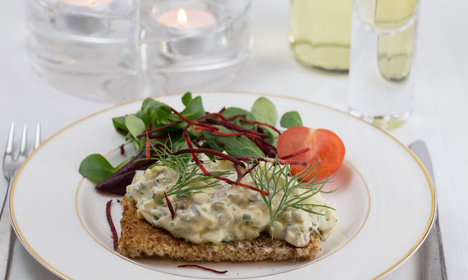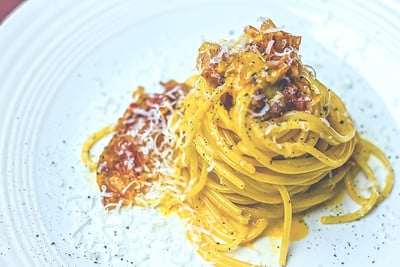'Gubbröra' is an easy-to-make, colourful egg and anchovies dish. Swedish anchovies ('ansjovis') are quite different to the Mediterranean kind so make sure you find the right version. To confuse matters even further, Swedish canned anchovies are not actually anchovies at all, but sprats ('skarpsill').
Summary
Serves: 4
Preparation: 5 minutes
Cooking: 15 minutes
Total: 20 minutes
Ingredients
- 4 eggs
- 125g (5 oz) tin of Swedish anchovies (sprats) or a 100g (4 oz) tin
- 1 red onion, finely chopped
- 3 tbsp sour cream
- 3 tbsp crème fraiche
- 3 tbsp dill, finely chopped
- 3 tbsp chives, finely chopped
- white pepper
- 4 slices bread, preferably rye
- salad for garnish
Method
1. Hard boil the eggs and cool under running cold water to prevent the outside of the yolks discolouring. Remove the shells and roughly chop the eggs.
2. Drain the anchovies, but keep the juice. Using a pair of scissors, finely chop the anchovies. Add to the eggs along with the finely chopped onion, sour cream, crème fraiche, dill and chives.
3. Have a taste and add some white pepper and perhaps a little bit of the juice from the anchovies. Go easy on the juice as it can leave an after taste and is not to everyone's liking.
4. Toast the bread (optional). Divide the mixture between the four pieces of bread and garnish with salad.
Tips
- A glass of Swedish snaps goes down very well with Gubbröra
- Don't season this dish with salt as there is already a lot of salt in the fish
- Gubbröra is often served as an appetiser. In this case, serve a mouthsized portion on a small round of thin, dark rye bread and garnish with a small slice of lemon
Recipe courtesy of John Duxbury, editor and founder of Swedish Food




 Please whitelist us to continue reading.
Please whitelist us to continue reading.
Member comments